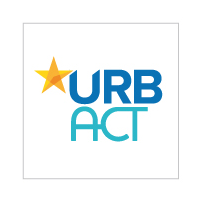The Arrival Cities project
Edited on
09 May 2016The Arrival Cities Action Planning Network is tackling one of Europe’s most urgent issues by looking at how cities can manage the challenges of old and new migration flows. Arrival Cities was initiated by Carla Tavares, the Mayor of the Municipality of Amadora, and Amadora is lead partner for the network. As Arrival Cities embarks on the six month phase of partnership development and network planning, Liz Mackie, the lead expert for the network, talked to the Deputy Mayor of Amadora, Cristina Farinha, about Amadora’s reasons for starting the Arrival Cities network, how the network will be developed and what she hopes they will gain from this experience. Ms Farinha became Deputy Mayor in October 2013, her portfolio includes education and training, social development, sport and youth, health, and management of co-financed processes.

Why did Amadora decide to set up an URBACT Action Planning Network?
Amadora was previously involved in URBACT, in the MILE network. We found the experience very useful. It helped us identify ways we could improve our interventions locally. More specifically, we decided to set up the Arrival Cities network because, like many cities, we are experiencing new flows of migration alongside ongoing difficulties in the integration of migrant groups which have been settled in the territory for many years. The URBACT programme provides a very useful vehicle to exchange learning and experience on these issues.
What is the main policy challenge you would like to address in the network?
The main policy challenges for Amadora are related to improving the integration of settled migrants into the labour market; improving school attainment level for certain groups of migrants; dealing with the ongoing negative stereotype that the majority population has of migrants; and dealing with new flows of migrants who are coming from places from which we have had no experience to date. Amadora formally adopted a Municipal Integration Plan in June 2015 which has been agreed by the Municipal Executive and endorsed by a number of local stakeholders. This provides important political weight to the work of the network.
Why did you choose to address migrant integration in the framework of an URBACT network?
It is clear that throughout the European Union there is a growing issue regarding integration and management of migration flows. The events of this year have really brought this issue into the spotlight. URBACT offers an opportunity for us to learn from other cities and also for us to share what we are doing. This cross fertilisation of experience and knowledge is why we have chosen the URBACT programme.
What concrete results do you expect to achieve through URBACT?
We are conscious that URBACT does not provide resources to take any actions on the ground so our ambitions are tailored to what is realistic. We would like to strengthen the Municipal Integration Plan by developing actions that could secure funding from our Operational Programmes for European Regional Development Fund and European Social Fund. This issue is a priority in both programmes and as such there are some real possibilities. We also want to strengthen local joint working and build trust between the different local actors that are connected to this issue. We can do this through the URBACT Local Group (ULG) that we will establish as requested by part of the URBACT networking framework. We are currently setting up our ULG. We have already arranged the first meeting of the group and also arranged the visit of the lead expert to develop the ULG contribution to the baseline study for Arrival Cities. The baseline study will set out the ‘state of the art’ on migration and migrant integration at EU level along with a local-level profile on this theme for each city in the Arrival Cities network.
How did you set up your initial partnership and why did you choose these partners?
We took part in a study tour in Vantaa focused on migrant integration, organised by the Local Urban Development European Network (LUDEN) of which we are members. During the event we presented a proposal to develop a learning exchange programme on this theme. Other study tour participants, including Vantaa, were eager to be involved in this. To find other cities interested in joining us we sent an outline proposal to cities who we have worked with at EU level in the past. We targeted cities in Greece, Italy and Spain which we know are in the front line of the recent flows of migration into the EU. We also looked for a balanced composition in terms of cities from developed and less developed regions.
What will be the next steps for Amadora as lead partner city in the six month development phase? What will be the challenges?
We are currently busy on several levels. In terms of project management and administration we are busy reading and making ourselves familiar with all the URBACT rules and procedures. We have never managed an URBACT network before so this is a steep learning curve for us. However, we have the support from our lead expert and we have also established an agreement with LUDEN which has many years of experience with the programme. We have also been very busy communicating with partners following the initial training provided by URBACT. This has involved ensuring that they quickly become aware of the key actions that they will need to undertake in phase one. We will reinforce this work at our first steering group meeting. In terms of challenges, one will be language as not all our ULG members and local politicians can work in English.
How do you foresee working with the partner cities?
Each partner has already sent us details of the key staff and politicians who will follow the work of the network. We know from having managed other EU projects that getting these lines of communication right is crucial. In the first phase we are planning to have two face to face steering group meetings plus one or possibly two telephone conferences as we know that it’s important to monitor progress regularly and not leave things too long. In addition we have set up a Facebook group and Twitter account to facilitate working between members of the ULGs that each partner will establish. However, we are aware that we need to explore ways that we can use automatic translation programmes in order to provide access to those members of the ULG who cannot work in English. In addition, at the first steering group meeting we will establish a detailed action plan with clear milestones which will form the basis of joint working with partners to ensure a successful transition to phase two.
How are you going to complete the partnership? Are you still looking for potential partners?
To be honest, we have been inundated with cities wishing to join our network. So far 35 cities have asked to join. We are currently looking at the cities who have applied and drawing up a shortlist to whom we will send more information about the network and also ask them some questions to ascertain if they will add value to our network. We will do this after our initial steering group meeting which will take place in Amadora in the last week of October.
 Submitted by URBACT on
Submitted by URBACT on
